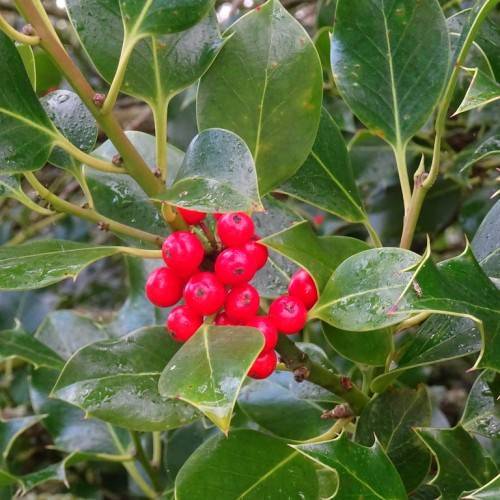
English holly
Ilex aquifolium
Cycle:
Perennial
Watering:
Average
Hardiness Zone:
7 - 9
Flowers:
Flowers In Spring
Sun:
Full sun, Part sun/part shade
Soil:
Acidic, Well-drained
Fruits:
Fruits In Autumn Ready In Autumn
Leaf:
Yes
Growth Rate:
Moderate
Maintenance:
Moderate
Poisonous To Pets:
Yes
Thorny:
Yes
Invasive:
Yes
Care Level:
Medium
watering
English holly (Ilex aquifolium) should be watered liberally in its first season, when newly planted in the garden. After this, water only when the top inch or 2 of soil is dry. Water thoroughly at least once per week until the soil is evenly moist and there is no runoff. Once established, English holly will require less watering, but during warm, dry weather it will appreciate being watered deeply (about 1" of water) once or twice per week.
sunlight
English holly prefers full sun, although it will also tolerate partial shade. This evergreen plant will benefit from at least 6 hours of direct sunlight each day, ideally during the mid-morning to mid-afternoon period. During the shorter, cooler days of winter, it will benefit from as much light as possible, especially in northern climates where winter days are often overcast or foggy. It is best to avoid planting it in a location that is too shady, as this may cause long-term damage to the foliage and prevent it from flowering and producing berries.
pruning
Pruning English holly (Ilex aquifolium) should be done on a regular basis during the growing season. Pruning should begin in late winter, cutting away any dead, broken, or diseased branches and shoots. Rejuvenating pruning can also be done in late winter, when older branches are pruned back to their common base point. This will promote new growth and increase the density of the plant. Deadheading or removing spent blooms should be done throughout the growing season to encourage more blooms. Finally, thinning out the interior branches can be done in late spring or early summer to prevent overcrowding and promote air circulation.
